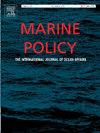计量国际海洋经济贸易:方法与应用
IF 3.5
2区 社会学
Q2 ENVIRONMENTAL STUDIES
引用次数: 0
摘要
随着海洋在国际经济中的重要性日益增加,海洋经济的统计是时候超越对国家经济份额的简单核算,而转向对国际贸易流量的统计和计量。本文基于“理论-方法-应用”的思路,在对海洋经济及其贸易统计核算理论进行全球回顾的基础上,对国际贸易分类码中符合筛选标准的产品进行重新分类,提出了包括海洋货物和服务贸易在内的贸易统计核算方法,并将该方法应用于2005 - 2021年全球海洋货物和服务贸易的计量。结果表明,在此期间,全球海洋贸易从5.85万亿美元大幅增长到11.20万亿美元,复合年增长率为4.14% %。海洋石油;货物贸易以天然气、海洋采矿和造船为主,服务贸易以海运、海洋信息服务和沿海旅游为主。海洋经济贸易的全球空间分布表现出多核心主体的动态,而不是通常假设的“世界三极”。使用这种方法,可以进行跨国家和跨部门的经济分析,并满足理论、会计和标准的一致性,学者可以利用这种方法进行可复制的研究,有助于实现海洋综合核算的更大目标,并扩大海洋经济及其政策的研究。本文章由计算机程序翻译,如有差异,请以英文原文为准。
Measuring the international ocean economy trade: Method and application
With the increasing importance of ocean in the international economy, it is time for the statistics of ocean economy to go beyond the simple accounting of national economic share, and move to the statistics and measurement of international trade flows. Based on the “Theory-method-application" approach and a global review of ocean economy and its trade statistics accounting theory, this paper reclassifies the products in the international trade classification code that meet the screening criteria, proposes an accounting method of trade statistics including ocean trade in goods and services, and applies the method to the measurement of global trade in ocean goods and services from 2005 to 2021. The results show that global ocean trade has grown substantially from $5.85 trillion to $11.20 trillion during this period, with a compound annual growth rate of 4.14 %. Offshore oil & gas, ocean mining, and shipbuilding dominate goods trade, while maritime transportation, marine information services, and coastal tourism account for the majority of services trade. Instead of the generally assumed “three poles of the world”, the global spatial distribution of ocean economy trade demonstrates that a dynamic of multiple core players. Using this method, it is possible to conduct economic analysis across countries and sectors and meet the consistency of theory, accounting, and standards, which can be used by scholars to conduct replicable research that can contribute to the larger object of integrated ocean accounts and expanding the research of ocean economy and its policies.
求助全文
通过发布文献求助,成功后即可免费获取论文全文。
去求助
来源期刊

Marine Policy
Multiple-
CiteScore
7.60
自引率
13.20%
发文量
428
期刊介绍:
Marine Policy is the leading journal of ocean policy studies. It offers researchers, analysts and policy makers a unique combination of analyses in the principal social science disciplines relevant to the formulation of marine policy. Major articles are contributed by specialists in marine affairs, including marine economists and marine resource managers, political scientists, marine scientists, international lawyers, geographers and anthropologists. Drawing on their expertise and research, the journal covers: international, regional and national marine policies; institutional arrangements for the management and regulation of marine activities, including fisheries and shipping; conflict resolution; marine pollution and environment; conservation and use of marine resources. Regular features of Marine Policy include research reports, conference reports and reports on current developments to keep readers up-to-date with the latest developments and research in ocean affairs.
 求助内容:
求助内容: 应助结果提醒方式:
应助结果提醒方式:


